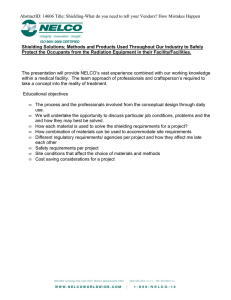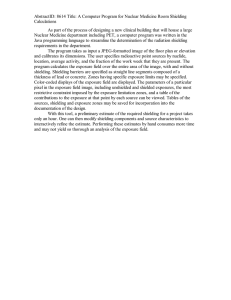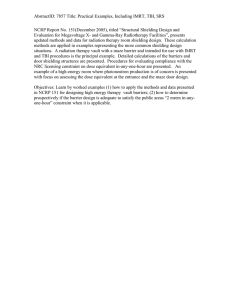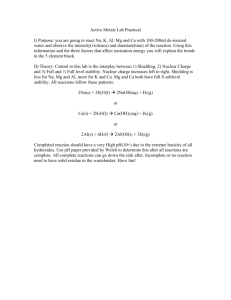RFI-EMI architectural shielding symptoms of the need
advertisement
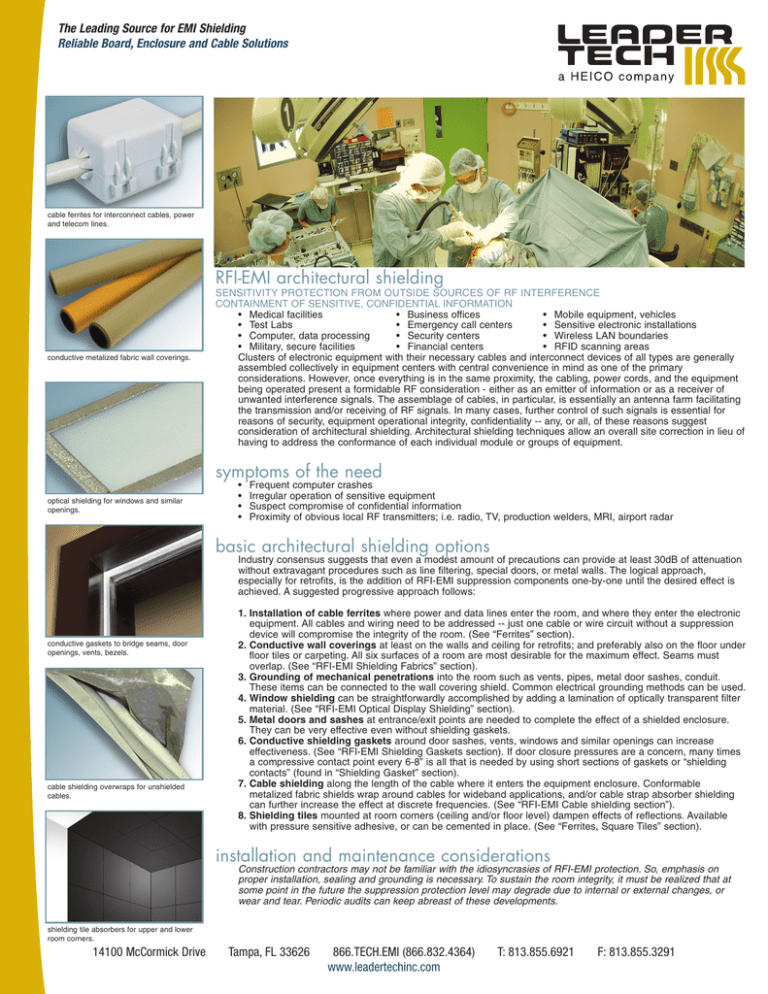
The Leading Source for EMI Shielding Reliable Board, Enclosure and Cable Solutions cable ferrites for interconnect cables, power and telecom lines. RFI-EMI architectural shielding conductive metalized fabric wall coverings. SENSITIVITY PROTECTION FROM OUTSIDE SOURCES OF RF INTERFERENCE CONTAINMENT OF SENSITIVE, CONFIDENTIAL INFORMATION • Medical facilities • Business offices • Mobile equipment, vehicles • Test Labs • Emergency call centers • Sensitive electronic installations • Computer, data processing • Security centers • Wireless LAN boundaries • Military, secure facilities • Financial centers • RFID scanning areas Clusters of electronic equipment with their necessary cables and interconnect devices of all types are generally assembled collectively in equipment centers with central convenience in mind as one of the primary considerations. However, once everything is in the same proximity, the cabling, power cords, and the equipment being operated present a formidable RF consideration - either as an emitter of information or as a receiver of unwanted interference signals. The assemblage of cables, in particular, is essentially an antenna farm facilitating the transmission and/or receiving of RF signals. In many cases, further control of such signals is essential for reasons of security, equipment operational integrity, confidentiality -- any, or all, of these reasons suggest consideration of architectural shielding. Architectural shielding techniques allow an overall site correction in lieu of having to address the conformance of each individual module or groups of equipment. symptoms of the need optical shielding for windows and similar openings. • • • • Frequent computer crashes Irregular operation of sensitive equipment Suspect compromise of confidential information Proximity of obvious local RF transmitters; i.e. radio, TV, production welders, MRI, airport radar basic architectural shielding options Industry consensus suggests that even a modest amount of precautions can provide at least 30dB of attenuation without extravagant procedures such as line filtering, special doors, or metal walls. The logical approach, especially for retrofits, is the addition of RFI-EMI suppression components one-by-one until the desired effect is achieved. A suggested progressive approach follows: conductive gaskets to bridge seams, door openings, vents, bezels. cable shielding overwraps for unshielded cables. 1. Installation of cable ferrites where power and data lines enter the room, and where they enter the electronic equipment. All cables and wiring need to be addressed -- just one cable or wire circuit without a suppression device will compromise the integrity of the room. (See “Ferrites” section). 2. Conductive wall coverings at least on the walls and ceiling for retrofits; and preferably also on the floor under floor tiles or carpeting. All six surfaces of a room are most desirable for the maximum effect. Seams must overlap. (See “RFI-EMI Shielding Fabrics” section). 3. Grounding of mechanical penetrations into the room such as vents, pipes, metal door sashes, conduit. These items can be connected to the wall covering shield. Common electrical grounding methods can be used. 4. Window shielding can be straightforwardly accomplished by adding a lamination of optically transparent filter material. (See “RFI-EMI Optical Display Shielding” section). 5. Metal doors and sashes at entrance/exit points are needed to complete the effect of a shielded enclosure. They can be very effective even without shielding gaskets. 6. Conductive shielding gaskets around door sashes, vents, windows and similar openings can increase effectiveness. (See “RFI-EMI Shielding Gaskets section). If door closure pressures are a concern, many times a compressive contact point every 6-8” is all that is needed by using short sections of gaskets or “shielding contacts” (found in “Shielding Gasket” section). 7. Cable shielding along the length of the cable where it enters the equipment enclosure. Conformable metalized fabric shields wrap around cables for wideband applications, and/or cable strap absorber shielding can further increase the effect at discrete frequencies. (See “RFI-EMI Cable shielding section”). 8. Shielding tiles mounted at room corners (ceiling and/or floor level) dampen effects of reflections. Available with pressure sensitive adhesive, or can be cemented in place. (See “Ferrites, Square Tiles” section). installation and maintenance considerations Construction contractors may not be familiar with the idiosyncrasies of RFI-EMI protection. So, emphasis on proper installation, sealing and grounding is necessary. To sustain the room integrity, it must be realized that at some point in the future the suppression protection level may degrade due to internal or external changes, or wear and tear. Periodic audits can keep abreast of these developments. shielding tile absorbers for upper and lower room corners. 14100 McCormick Drive Tampa, FL 33626 866.TECH.EMI (866.832.4364) www.leadertechinc.com T: 813.855.6921 F: 813.855.3291
